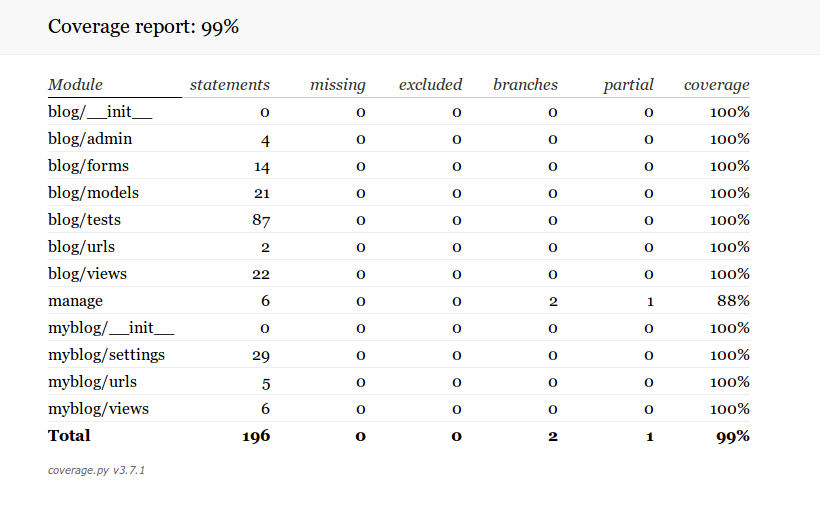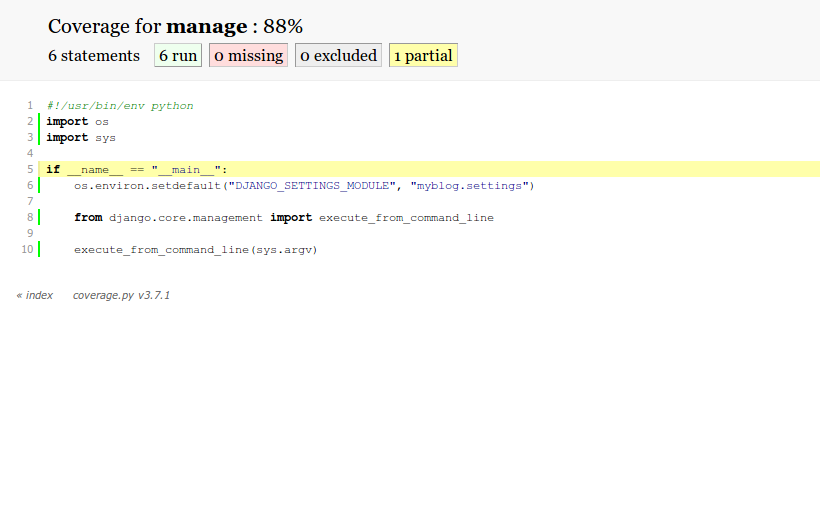The Testing Game¶
Test Coverage¶
It’s important to test all your code. Code coverage is frequently used as a measuring stick for a developer’s success in creating quality tests. The basic rule of thumb is comprehensive tests should execute every line of code.
Coverage, a tool that measures code coverage for Python code, will be used to check what percentage of the tutorial code is being tested.
Installing Coverage¶
First let’s install coverage:
$ pip install coverage
Before we continue, we need to remember to add this new dependency to
our requirements.txt file. Let’s use pip freeze to discover
the version of coverage we installed:
$ pip freeze
Django==1.7
WebOb==1.4
WebTest==1.4.3
beautifulsoup4==4.3.2
coverage==3.7.1
django-webtest==1.7.7
six==1.8.0
sqlparse==0.1.13
waitress==0.8.9
Now let’s add coverage to our requirements.txt file:
coverage==3.7.1
Django==1.7
WebTest==2.0.16
django-webtest==1.7.7
Using Coverage¶
Now let’s run our tests. As we run our tests from the command line,
coverage records and creates a coverage report:
$ coverage run --include='./*' manage.py test
Creating test database for alias 'default'...
....................
----------------------------------------------------------------------
Ran 20 tests in 0.163s
OK
Destroying test database for alias 'default'...
Let’s take a look at our code coverage report:
$ coverage report
Name Stmts Miss Cover
-------------------------------------------------------------
blog/__init__ 0 0 100%
blog/admin 4 0 100%
blog/forms 14 0 100%
blog/migrations/0001_initial 6 0 100%
blog/migrations/0002_auto_20141019_0232 5 0 100%
blog/migrations/__init__ 0 0 100%
blog/models 23 0 100%
blog/tests 101 0 100%
blog/urls 3 0 100%
blog/views 18 0 100%
manage 6 0 100%
myblog/__init__ 0 0 100%
myblog/settings 19 0 100%
myblog/urls 5 0 100%
myblog/views 5 0 100%
-------------------------------------------------------------
TOTAL 209 0 100%
Let’s take a look at the coverage report. On the left, the report shows
the name of the file being tested. Stmts, or code statements,
indicate the number of lines of code that could be tested. Miss, or
Missed lines, indicates the number of lines that are not executed by
the unit tests. Cover, or Coverage, is the percentage of code
covered by the current tests (equivalent to (Stmts - Miss)/Stmts).
For example, myblog/views has 18 code statements that can be tested.
We see that our tests did not miss testing any statements for a Code
Coverage of 100%.
Important
Note that code coverage can only indicate that you’ve forgotten tests; it will not tell you whether your tests are good. Don’t use good code coverage as an excuse to write lower quality tests.
HTML Coverage Report¶
Our current command-line coverage reports are useful, but they aren’t very detailed. Fortunately coverage includes a feature for generating HTML coverage reports that visually demonstrate coverage by coloring our code based on the results.
Let’s prettify the coverage report above into HTML format by running the following command:
$ coverage html
This command will create a htmlcov directory containing our test
coverage. The index.html is the overview file which links to the
other files. Let’s open up our htmlcov/index.html in our web
browser.
Our HTML coverage report should look something like this:

Branch Coverage¶
So far we’ve been testing statement coverage to ensure we execute every line of code during our tests. We can do better by ensuring every code branch is taken. The coverage documentation contains a good description of branch coverage.
From now on we will add the --branch argument when we record code
coverage. Let’s try it on our tests:
$ coverage run --include='./*' --branch manage.py test
$ coverage report
Name Stmts Miss Branch BrMiss Cover
---------------------------------------------------------------------------
blog/__init__ 0 0 0 0 100%
blog/admin 4 0 0 0 100%
blog/forms 14 0 0 0 100%
blog/migrations/0001_initial 6 0 0 0 100%
blog/migrations/0002_auto_20141019_0232 5 0 0 0 100%
blog/migrations/__init__ 0 0 0 0 100%
blog/models 23 0 0 0 100%
blog/tests 101 0 0 0 100%
blog/urls 3 0 0 0 100%
blog/views 18 0 0 0 100%
manage 6 0 2 1 88%
myblog/__init__ 0 0 0 0 100%
myblog/settings 19 0 0 0 100%
myblog/urls 5 0 0 0 100%
myblog/views 5 0 0 0 100%
---------------------------------------------------------------------------
TOTAL 209 0 2 1 99%
Notice the new Branch and BrMiss columns and note that we are
missing a branch in our manage.py file. We’ll take a look at that
later.
Coverage Configuration¶
Coverage allows us to specify a configuration file (.coveragerc
files) to specify default coverage attributes. The documentation
explains how .coveragerc work.
Let’s add a .coveragerc file to our project that looks like this:
[run]
include = ./*
branch = True
Now we can run coverage without any extra arguments:
$ coverage run manage.py test
Inspecting Missing Coverage¶
Now let’s figure out why our branch coverage is not 100%. First we need to regenerate the HTML coverage report and have a look at it:
$ coverage html

Let’s click on manage to see why our manage.py file has 88%
coverage:

We’re missing the False case for that if statement in our
manage.py file. We always run manage.py from the command line
so that code is always executed.
We don’t intend to ever test that missing branch, so let’s ignore the issue and accept our imperfect coverage statistics.
Tip
For extra credit, figure out how we can exclude that
if __name__ == "__main__": line from our coverage count. Check
out the .coveragerc documentation for help.